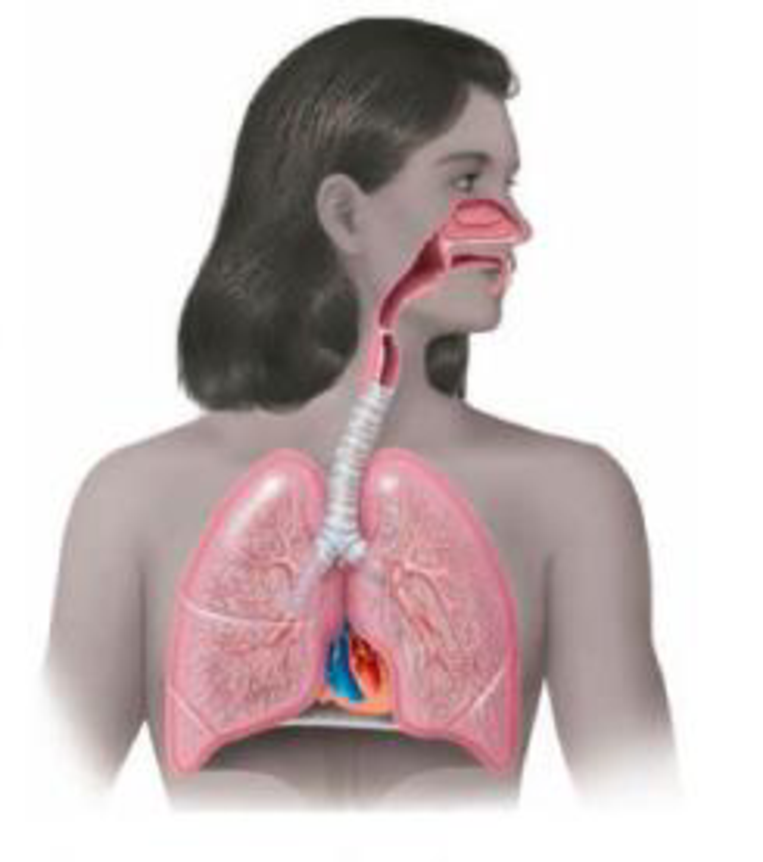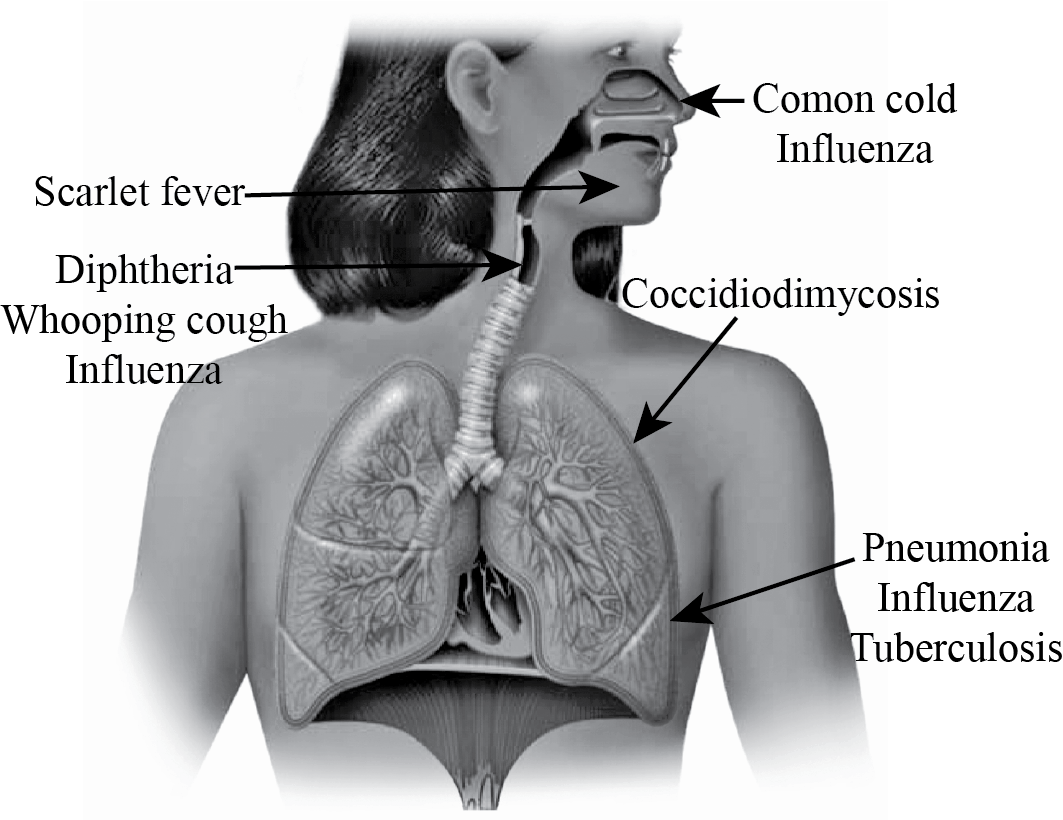
DRAW IT Show the locations of the following diseases: common cold, diphtheria, coccidioidomycosis, influenza, pneumonia, scarlet fever, tuberculosis, whooping cough

To determine:
The location of following diseases of common cold, diphtheria, coccidioidomycosis, influenza, pneumonia, scarlet fever, tuberculosis and whooping cough.
Concept introduction:
Respiratory system consists of two parts, lower and upper parts. Bacteria and virus affects both the parts but lower parts may affects highly than upper parts.
Explanation of Solution
Diagram:
Diseases of Respiratory system

Respiratory system causes diseases which are affected by both bacteria and virus. The upper part causes disease like common cold, diphtheria and whooping cough. Common cold is a viral infection of the upper respiratory system. It is caused by rhinovirus and coronavirus. Scarlet fever caused by streptococcal exotoxin, affects the skin by reddening of tongue and peeling of affected skin. Diphtheria caused by Corynebacterium diphtheria, causes sore throat and swelling of neck. Whooping cough is another disease caused by Bordetella pertussis, tracheal cytotoxin. It affects the cilia and damages the respiratory passages.
Pneumonia causes lower respiratory infection and leads to same symptoms as cold, cough, headache and fatigue and so forth. Pneumonia is the disease of the lower respiratory system. Influenza is characterized by fever, chills, muscular aches and headache. Mycobacterium tuberculosis is a gram positive, rod and an obligate aerobe that causes tuberculosis. It is also a lower respiratory infection.
Many virus can enter into our respiratory system although there is a constant inhibition of pathogens by cilia and mucous membrane. Mostly the upper part is affected but only the lower part is affected by virus infection.
Want to see more full solutions like this?
Chapter 24 Solutions
Pearson eText Microbiology: An Introduction -- Instant Access (Pearson+)
Additional Science Textbook Solutions
Biological Science (6th Edition)
Laboratory Manual For Human Anatomy & Physiology
Campbell Biology in Focus (2nd Edition)
SEELEY'S ANATOMY+PHYSIOLOGY
Living By Chemistry: First Edition Textbook
Biology: Life on Earth with Physiology (11th Edition)
- identify the indicated cell in white arrowarrow_forwardGloeocaspa Genus - diagram a colony and label the sheath, cell wall, and cytoplasm. Oscillatoria Genus - Diagram a trichome, and label the shealth and individual cells Nostoc Genus- diagram a sketch of the colonoy microscopically from low power to the left of the drawing. Draw a filament showing intercalary heterocysts, and vegatative cells to the right of the drawing Merismopedia Genus- diagram a sketch of the colony. draw and label a filament showing the colony, cell wall, and sheath. Gloeotrichia Genus- diagram a habit sketch of the colony. draw a filament showing the heterocyst, akimetes and vegatative cells of the filamentarrow_forwardOf this list shown, which genus does the image belong toarrow_forward
- As a medical professional, it is important to be able to discuss how genetic processes such as translation regulation can directly affect patients. Think about some situations that might involve translation regulation. Respond to the following in a minimum of 175 words: Why is translation regulation important? What are some examples of translation regulation in humans? Select one of the examples you provided and explain what happens when translation regulation goes wrong.arrow_forwardThe metabolic pathway below is used for the production of the purine nucleotides adenosine monophosphate (AMP) and guanosine monophosphate (GMP) in eukaryotic cells. Assume each arrow represents a reaction catalyzed by a different enzyme. Using the principles of feedback inhibition, propose a regulatory scheme for this pathway that ensures an adequate supply of both AMP and GMP, and prevents the buildup of Intermediates A through G when supplies of both AMP and GMP are adequate.arrow_forwardQUESTION 27 Label the structures marked A, B, C and explain the role of structure A. W plasma membrane For the toolbar, press ALT+F10 (PC) or ALT+FN+F10 (Mac). BIUS ☐ Paragraph Π " ΩΘΗ Β Open Sans, a... 10pt EEarrow_forward
- examples of synamptomorphyarrow_forwardexamples of synamtomorphy.arrow_forwardE. Bar Graph Use the same technique to upload the completed image. We will use a different type of graph to derive additional information from the CO2 data (Fig A1.6.2) 1. Calculate the average rate of increase in COz concentration per year for the time intervals 1959-1969, 1969- 1979, etc. and write the results in the spaces provided. The value for 1959-1969 is provided for you as an example. 2. Plot the results as a bar graph. The 1959-1969 is plotted for you. 3. Choose the graph that looks the most like yours A) E BAR GRAPH We will use a different type of graph to derive additional information from the CU, data (rig. nive). Average Yearly Rate of Observatory, Hawall interval Rate of increase per year 1959-1969 0.9 1969-1979 1979-1989 1989-1999 1999-2009 Figure A1.6.2 1999-2009 *- mrame -11- -n4 P2 جية 1989-1999 1979-1989 1969-1979 1959-1969 This bar drawn for you as an example 1.0 CO, Average Increase/Year (ppmv) B) E BAR GRAPH We will use a different type of graph to derive…arrow_forward
 Comprehensive Medical Assisting: Administrative a...NursingISBN:9781305964792Author:Wilburta Q. Lindh, Carol D. Tamparo, Barbara M. Dahl, Julie Morris, Cindy CorreaPublisher:Cengage Learning
Comprehensive Medical Assisting: Administrative a...NursingISBN:9781305964792Author:Wilburta Q. Lindh, Carol D. Tamparo, Barbara M. Dahl, Julie Morris, Cindy CorreaPublisher:Cengage Learning Medical Terminology for Health Professions, Spira...Health & NutritionISBN:9781305634350Author:Ann Ehrlich, Carol L. Schroeder, Laura Ehrlich, Katrina A. SchroederPublisher:Cengage Learning
Medical Terminology for Health Professions, Spira...Health & NutritionISBN:9781305634350Author:Ann Ehrlich, Carol L. Schroeder, Laura Ehrlich, Katrina A. SchroederPublisher:Cengage Learning Microbiology for Surgical Technologists (MindTap ...BiologyISBN:9781111306663Author:Margaret Rodriguez, Paul PricePublisher:Cengage Learning
Microbiology for Surgical Technologists (MindTap ...BiologyISBN:9781111306663Author:Margaret Rodriguez, Paul PricePublisher:Cengage Learning





